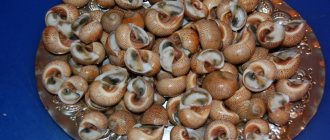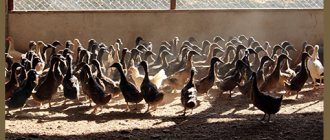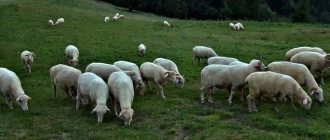Quite a few beginning farmers want to start making money from goose farming. When you see the prices for geese in a store, you might think that the business is bringing in a lot of money. But when they try to raise poultry themselves, they realize that this is an extremely difficult and very risky business.
Why is breeding geese not as widespread as, for example, raising chickens? There are several reasons for this:
- The demand for goose is extremely unstable throughout the year. Most often, the bird is taken for New Year and Christmas. In addition, the demand for goose meat greatly depends on the region.
- The goose is picky about living conditions. Keeping him in cages with several tiers, like a chicken, is unacceptable. Geese require grazing, pens, and large areas. Not every farmer is able to create such conditions.
- Returning to the problem of sales: goose is a delicacy that is not cheap. And today many people have to save money.
Some tips for raising geese on a mini-farm
The goose is an unpretentious bird. The main task of the farmer is to ensure that his plumage is not disturbed. Therefore, the bird should be outside most of the time. Excess moisture and dirt, which traditionally accumulate indoors, have an extremely negative effect on the health of the goose.
Ideally, there should be a pond near the goose farm, but there are several important points. First, it makes geese control more difficult. And secondly, not every pond is suitable for poultry walking from the point of view of the law.
The fact is that intensive use of the pond for keeping geese makes the bottom of the reservoir silty, which over time leads to its shallowing or complete drying out. For this reason, keeping geese in some bodies of water is prohibited. You might be interested:
- Business plan for breeding geese
- Quail farm as a business
- Mini poultry farm as a business
Business plan
► In addition to the stage of selecting a breed, it is also necessary to carry out:
- legal registration of the poultry farm and obtaining permits;
- construction of a poultry house;
- organization of feeding;
- organization of geese breeding;
- organization of sales of goose products;
- planning of financial indicators.
► Business is usually developed in two directions:
- Fattening ducklings and selling meat.
- Breeding geese for sale.
More experienced farmers combine both approaches to increase profits.
Reproduction of geese
Nests for planting eggs are made from planks. The average size of the nest is 50 x 70 cm. The entrance to the nest must be made with a threshold 10 cm high so that the litter (straw) does not fall out of the nest.
When reproducing a flock, the question of incubating a goose egg will naturally arise. You can purchase incubators, or you can simply hand over eggs for incubation to third-party farmers, as they do on Daniil Penchalov’s farm.
You will be charged a fee for this, but it may be more profitable than spending money on buying expensive incubators and monitoring the entire process of hatching goslings.
Useful tips for beginners
Despite its apparent simplicity, novice poultry farmers may encounter some difficulties. To minimize their occurrence, you need to follow some recommendations:
- before opening a farm, carefully study the conditions for keeping geese;
- to begin with, choose the most unpretentious and hardy breed for breeding;
- buy chicks only from trusted farmers;
- keep the room clean;
- systematically ventilate the area where the poultry is kept;
- thoroughly clean and disinfect the poultry house regularly;
- to minimize the cost of purchasing young animals, leave a certain number of birds for posterity before slaughter;
- the day after birth, the chicks are given a weak solution of potassium permanganate for general strengthening;
- During the first 2 months of life, it is recommended to give drugs for immunity.
If you are completely confident in your abilities and know first-hand how to farm, then goose farming is for you. The most important thing is to draw up an accurate business plan and assess all possible risks. Only careful preparation and desire will lead to a positive result.
What equipment to choose for plucking geese
Raising a goose is not everything. The fun begins when it’s time to take the bird to slaughter. Cleaning an adult goose weighing under 5 kg with “bare” hands is an extremely difficult task. And if you need to score 100 goals a day, the first truly serious problems appear, which some beginning farmers did not foresee when planning their business. In this case, you cannot do without a feather removal machine, for example “Sprut-700”. The price of the device is from 55,000 rubles.
This unit operates on the principle of a centrifuge, the working parts of which are rubber pins. Plucking one bird takes about a minute.
According to farmers, it is profitable to keep a goose for no more than 4 months. During this period, the bird gains maximum weight and reaches 3.2 - 3.7 kg. Further, the increase in body weight is no longer so intense, and keeping the goose becomes unprofitable.
Popular breeds for keeping: Lindovsky, Kholmogory and Governor's geese. The Governor breed is the youngest and most efficient to grow. This goose was bred in Russia in 2011. In just 9 weeks (a little over 2 months), ganders gain 4.35 kg in weight, and geese gain 4.00 kg. Feed consumption for an increase in one kg of live weight is 2.75 kg.
Egg production per productivity cycle – 46 pcs. There is a subtlety in reproducing a flock, described in some textbooks on goose farming. To get fast-growing young animals, it is necessary to cross a male of one breed of goose with a female of another breed. As a result, you will get young animals that will grow faster than purebreds.
Breeding
Experts advise purchasing females and males from different producers to avoid family ties. Geese with a similar gene pool produce poor offspring.
The largest and most aggressive goose from the herd is selected for breeding. Signs of a good bird are:
- Two small scissor-shaped feathers on the wings.
- Ten flight feathers of the first and second order.
- Ten upper and lower tail feathers.
Males can fertilize females for 8-10 years, with 3-5 geese per goose. To maintain the stock in excellent condition, it must be supplemented by about a third with new young birds.
The egg laying period is from late February to early March. To obtain a brood of the same age, the collected eggs are placed with the sharp end down in a dry room with a temperature of 7-13 degrees, where they can be stored for a month with constant turning.
After this, they are collected and placed in nests with hens. Until this moment, there is only one egg under the geese, which is removed when they are laid. The chicks hatch after a month, for which purpose they are sprinkled with water on the 28th day.
The quality must be controlled using an ovoscope device. Signs of a defective egg are:
- non-standard shape, color or size;
- double yolk;
- the yolk is offset from the center;
- protein with spots.
During the season, the female hatches 4-5 goslings; when eggs are laid in the incubator, this figure increases 2-3 times. If you have 20 geese, you can breed a flock of 100 heads in one year.
How much can you earn by opening a goose farm?
The retail price of goose meat is from 450 rubles/kg. Farm-raised goose sells well in Moscow - it is advertised as environmentally friendly. The minimum price for such goose meat is 600 rubles/kg.
If the average weight of an adult carcass is 4 kg, we earn 2400 rubles from one head. From 1000 heads the revenue will be 2.4 million rubles. The structure of costs for maintaining a goose before slaughter looks something like this: 80% is spent on feed, 15% on the employee’s salary and 5% on other expenses.
Each farmer will have his own final cost. You can buy food at different prices. In the Moscow region, the price of mixed feed will be higher than in the Krasnodar Territory. One farmer can feed the birds exclusively with compound feed, while a more prudent one will dilute the diet with grain waste.
According to experienced farmers, the most profitable direction in goose farming is the sale of hatching eggs and young stock. Thus, the price for a goose hatching egg is at least 70 rubles. One week old gosling. will cost at least 350 rubles. They brought out 1,000 goslings and sold them for 350,000 rubles. - you don’t need to do anything else. And if you leave them for meat, you will have to invest in maintenance, feeding, wages, etc. And what is most surprising is that the demand for young animals is much higher than for ready-made meat.
A goose farm can also make money by selling goose liver, down and fat. If you invest additionally, you can start processing meat - for example, producing smoked geese. Some large farms also make money by selling cages, drinkers, feeders, feed, hay and even goose breeding waste (manure).
It’s easier to find clients via the Internet. The website can be made in business card format. Such a project will cost 5-10 thousand rubles. You should definitely post information on Avito.
Sales of goslings and hatching eggs are launched after information is posted on specialized forums about poultry farming. After a year or two of active advertising, you may have a queue of regular customers and people who came through word of mouth.
Documents and licenses
You can register as an LLC or a peasant (farm) enterprise. It all depends on the size of the business. Regardless of how you plan to sell your products, certification is required.
You must request documentation from the nursery when purchasing your first geese. Your farm must also be inspected by the veterinary service and the SES to ensure compliance with all requirements. In the future, such checks will be carried out regularly.
In the case of registering a peasant farm, about 25,000 rubles should be prepared for paperwork.
Step-by-step plan: where to start
- You can rent a ready-made poultry house or look for a place to build your own.
- Construction materials are purchased (mesh, hardware, boards, slate).
- An enterprise or peasant farm is registered.
- Young animals of forage meat breeds and compound feed are purchased.
- 1-2 permanent employees are hired.
- While the poultry is growing, channels are being looked for for the delivery of meat products.
Professional business plans on the topic:
- Poultry farm business plan (16 sheets) - DOWNLOAD ⬇
- Business plan for an ostrich farm (17 sheets) - DOWNLOAD ⬇
How much money do you need to start
? Start-up capital for a goose breeding business should be at least 350 thousand rubles. This money will be needed to purchase a poultry house, which will pay for the farm in a few months.
It is better to immediately purchase a feather plucking machine and a freezer. This will cost approximately 300,000 rubles. At least another 200 thousand are needed to equip the poultry house. Total: 850 thousand rubles. If you don't have initial capital, attract investors.
Equipment
The room for keeping geese should be spacious. The norm is 1 m² for four birds. Geese are not afraid of the cold. But the temperature in the poultry house should not fall below +10°C, for some breeding breeds - not below +28°C. This means that additional heating will be needed for the winter. The best option is to insulate the floor, since these birds' feet suffer the most from the cold. Drafts and dampness are not allowed in the wintering room. Install shelves with nests, drinkers and feeders.
Chicks require additional heating. It is recommended to buy an incubator and infrared lamps as soon as possible, and equip a special room for the goslings. Costs of 60,000-70,000 rubles will be reimbursed not only by reducing the loss of chicks, but will also make it possible to earn money from their sale.
Also, a special room should be equipped for storing feed during the winter. By spring, their cost increases sharply. You should save supplies from the fall until the first greenery appears, when the geese can go out to graze. This means that it is important to equip the room with effective ventilation and protect it from excessive humidity.
To freeze carcasses you need an industrial freezer. First, you can look for an affordable, used option. If you plan to prepare food yourself, you need a mini-tractor with a trailer. In any case, transport should be purchased as soon as possible - delivery of products always falls on the shoulders of the supplier.
On average, setting up a poultry house and purchasing equipment for keeping 1,000 geese will cost 200,000-250,000 rubles.
Cultivation and sales technology
Based on the feed consumption rates of each bird and the farm population, it will be possible to calculate the total costs of the project. The technology comes down to the following points:
- When building a poultry house, it should be assumed that each individual should have at least 1 sq.m. squares;
- for every 1 kg of body weight gain, each bird must eat 3.5 kg of feed;
- It is profitable to slaughter a bird when it reaches 2-3.5 kg of weight; subsequently it becomes less profitable;
- for implementation it is necessary to conclude agreements with cafes and restaurants, as well as meat markets and pavilions;
- It makes sense to open your own retail outlet with the long-term prospect of developing the network.
( 11 ratings, average: 4.00 out of 5)
Loading…
Similar business ideas:
- We raise poultry to order, we work for a restaurant
- TOP 30 business ideas with minimal investment
- TOP 30 business ideas without investment
- Growing turkeys as a business
Calculation of income and profitability
A significant advantage of initial spending is the quick payback. To achieve the optimal weight for slaughter (5 kg), the bird will need about 3 months. The optimal weight is 10 kg at 3.5 months. Almost all breeds have a high egg production rate, approximately 70 eggs per month. In addition, other products are in demand on the market.
One carcass weighing 5 kg costs about 400 rubles. A heavier one can bring an income of 700 rubles. The average farm has about 1 thousand animals. Therefore, you can receive an income of approximately 2 million rubles. Knowing all the costs and income, it can be calculated that the profitability of the goose business is up to 80%.
We recommend learning how to easily and quickly pluck a goose at home.
Buildings on the ground
In order to be able to develop the land with buildings, it is necessary to obtain a building permit. What kind of buildings there will be and in what quantity the businessman himself decides. This is regulated by the article of the Federal Law “On Peasant Farms” of 2003. It reflects the standards for the area required to keep poultry. The area of buildings cannot exceed the area of pastures. And the size of the poultry house is calculated depending on the number of geese - from 0.8 to 1 square. meters per unit.
Pasture for geese
The presence of pasture is the main condition for breeding geese. Its size can vary depending on the number of heads, the type of bird, and the quality of the greenery growing on it. If there is a pond, the area can be halved.
On average, if the reservoir is inaccessible and the vegetation is poor, 25 acres are required per 100 birds.
If the birds are fed, the grazing area can be reduced by a third. You can save a lot on pasture if you choose an allotment in an area remote from the city. It will not cost much.
Poultry house requirements
The bird spends a small part of its time in the goose barn; it mostly prefers to be out on the run. But for recreation, a poultry house is still necessary. Any outbuilding is suitable for it; it is advisable that the thickness of its walls be at least 3 cm.
The building area should provide each goose with one square meter. m. area. In this case, the passage must be at least 2 meters in height, and the height of the walls of the gooseneck - up to 1.5 meters.
The bird must be protected from drafts by maintaining dry air in the goose coop. It is advisable to repair the roof and patch holes in the walls using a clay-based mixture.
Geese are an unpretentious bird, but they still have weak points. These are the beak and paws. Therefore, a dry floor in the goose barn is important. Usually it is covered with hay, which you can prepare yourself, or you can purchase it separately for these purposes. The costs for it will amount to 30 thousand rubles.
To allow bird droppings to be used as fertilizer, the litter is sprinkled with superphosphate, which neutralizes ammonia. The quality of litter depends on the regularity of cleaning and disinfection of the premises.
It is important to divide the poultry house into several areas where young geese will be kept separately from adults. You should also provide the geese with nests and build partitions between them to avoid conflicts between females hatching eggs. Nests measuring 60x70 cm are constructed from boards so that the heads of geese do not fit between the holes. The height of the walls should be 15-20 cm. Bedding is placed at the bottom of each nest, and a wide layer of down is placed on top of it.
The number of eggs laid by a female directly depends on the duration of her walking. For this purpose, you can build special enclosures.
For walking chicks, about 1 square meter is required. meters for each individual, for young animals - 5 square meters. m., adults - 15 sq. m.
Poultry purchase, care and breeding
Initially, chicks can be bought at a poultry farm or market. The price often depends on the quantity purchased, breed, age. The average cost of one goose is 100 rubles. To get started, you will need 300-500 birds.
Feeding geese
You should immediately think about feeding and caring for geese. They require convenient feeders, drinkers, and nests. To breed chicks in the future, you will need to purchase incubators.
To produce a quality product, geese need to be watered and fed several times a day. They are unpretentious in food; any food without harmful additives will do. The packaging of good food is impenetrable and should not allow sunlight to pass through. The release date is indicated on the seam of the bag. It is better not to choose loose feed. It is not recommended for these birds to add rye to their diet; it slows down the process of deposition of high-quality fat.
Geese love to walk in open areas. This allows you to significantly save on fertilizing. Among herbs they prefer plantain, dandelion leaves, and young nettle. One bird can eat up to 1.5 kg of grass per day.
Vegetable protein should be added to the diet. Peas, beans, beans, and sunflower cake are suitable for this. Legumes must first be soaked in water.
Breeding
An incubator is a must for breeding birds. Most breeds of geese do not cope with the task of incubating and breeding young animals.
For goslings, you need to control the temperature. Their premises should be clean and without high humidity. It is better to whiten surfaces. The chick does not need heating until after three weeks of life. If the chicks behave restlessly, it means they do not have enough lighting. The backlight can be left on at night.
A growing body requires special nutrition. For the first five days, the goslings are fed every two hours. The diet of chicks should include boiled eggs of any birds, fatty cottage cheese, preferably home-made, and fish oil, which is sold in specialized stores. After 10 days of life, potassium permanganate should be added to the water. It is imperative to provide free access to water. Birds not only drink it, but also use it to wash their beaks.
Care
Geese have strong immunity and are rarely exposed to disease. But it is still worth thinking about the safety of birds and products. To do this you need:
- Comply with all sanitary requirements for keeping birds.
- Provide ongoing veterinary support.
- Conduct vaccinations.
The bird room should always be dry. Wet, sawdust-like flooring should be cleaned and renewed regularly. This needs to be controlled especially strictly in the winter season. All drafts should be excluded. The weakest points of a bird are its paws and beak. They should always be dry and clean.
Birds should be housed according to age characteristics. It will be difficult for young animals to be around large mature relatives. It is better to protect the nests of females hatching chicks from each other.
Breeds
Let's look at the most popular breeds of geese for breeding:
- Toulouse
. These geese were bred by the French. Valued for its liver. They are distinguished by their large body weight and fat content. They are inactive, which makes them susceptible to colds. Weight - up to 12 kg; - Edmenskaya
. Large and fat geese. Weight - up to 10 kg; - Gorkovskaya
. Meaty geese. Weight - up to 10 kg. Eggs in a clutch - up to 50 pieces; - Arzamasskaya
. Medium sized geese. Delicious meat. Little susceptible to disease. Weight - about 7 kg. - Kholmogorskaya
. Large geese. Weight - up to 10 kg. Eggs in a clutch - up to 40 pieces. - Italian white
. Large geese, growing quickly. Weight - up to 9 kg. Eggs in a clutch - up to 50 pcs. - Kubanskaya
. It is a small bird, but has a high egg production. Weight - up to 6 kg. Eggs in a clutch - up to 90 pieces. - Gray
. Large geese. Weight - up to 10 kg. Eggs in a clutch - up to 40 pcs. - Danish legart
. The geese are large. They gain weight quickly. Requires 20% less feed than other breeds. The weight of two-month-old geese is 6 kg. - Rhine white
. Medium sized bird. Very tasty meat. Great egg production. Weight - up to 6.5 kg. Eggs in a clutch - up to 50 pcs.
Thus, focusing on the characteristics of a particular breed of bird, it is possible to combine or cross them to obtain the greatest benefit.
Raising geese as a business - choosing the right goslings!
When you have decided on the breed, you need to go to a poultry farm, incubator or market and select goslings. But how not to make a mistake and choose a product that will satisfy all your requirements, and also bring home healthy goslings, not sick and active? To do this, we follow the basic rules:
- we purchase goslings only with documents or in trusted places - this will guarantee that you will take the breed you need (if it is not possible to determine it “by eye”);
- choose only the noisiest and most active goslings. By analogy with breeding ducks and chickens, geese must be restless, react to any noise, and make sounds. If this does not happen, the geese are most likely sick;
- butts should be dry, the fluff should be clean and shiny;
- Even a small gosling should already be firmly on its feet for 3-5 days; if it sits or cannot stand up, it is better to refuse such a product.
Important: goslings must be transported only in a well-ventilated cardboard box so that the birds are not injured on a hard surface and also have access to air, otherwise they may suffocate.
Stern
In summer, geese get their main food from grazing. The presence of fresh greens in the diet is very important for these birds. But it is also necessary to feed them with grains and special feed. The calculation depends on the breed.
Most farms reduce their livestock numbers to a maximum in the fall. This is due to the fact that by autumn the goslings reach the age of 2-3 months and an average weight of 4-6 kg. At this age and after summer grazing, meat has the highest nutritional value. Profitability is about 115%.
Leaving birds for the winter reduces your profitability by 7% each month. This is influenced by 2 factors - the cost of feed for the winter period and a decrease in the nutritional value of meat.
Supplies of grain and mixed feed should be calculated based on the norm of 0.5 kg per bird per day. Be sure to add vitamins, about 70 g per day.
Keeping birds in winter makes sense if you plan to sell goslings. Even with an incubator and heat lamps for the chicks, they survive better if a goose is nearby. But breeds intended for fattening are not suitable for this method of earning money. To breed goslings, you should buy breeding birds.
Keeping and feeding geese
How to keep and fatten geese is well known and described in detail in specialized literature. We can only mention that geese require quite a lot of greenery, succulent food and water.
It should also be noted that a good income from a large flock of geese can be obtained independently only by grazing. “Stable” housing is beneficial on an industrial scale for canned food or when fattening several dozen for holidays and celebrations. But this is no longer breeding, but another type of activity - fattening.
Risks and payback
Business risks:
- Problems with obtaining certificates and certificates of product quality.
- Diseases and illnesses in birds.
- Insufficient egg production of birds.
- Unplanned high mortality of geese.
- Higher feed costs than originally planned.
The return on business is quite high. The more geese raised on the farm, the faster the project will pay off. Medium and large farms (from 500 birds) bring good income and pay for themselves in just 12 months.
Geese care technology
Goslings purchased for business must be placed and kept in several sections with a heating system.
The initial heating temperature should reach 30 degrees. Gradually, this value decreases and becomes equal to 22 degrees when the geese reach three weeks of age. In order for goslings to gain weight faster and be completely healthy, it is necessary to include additional vitamins in their diet and carry out timely prevention. The composition of ordinary mixed feed includes all the necessary vitamins. But, if the quantity is insufficient, they can be bought. Vitamin granules, first diluted with warm drinking water and given to geese.
Antibiotics
Antibiotics occupy a special place in the business of raising geese for marketing meat products. The ability of the bird’s stomach to produce the necessary enzymes depends on them; they make the geese get used to the food.
They are given to the chicks immediately after being placed in separate sections for rearing. The course of antibiotics is repeated after the geese reach one month of age. As a result, the bird's immune system is strengthened.
To make geese grow faster, you can keep them on food with special nutritional supplements. But at the same time, you need to remember that artificial and chemical ones can cause great harm to birds and your meat business. Therefore, when raising young animals, it is necessary to use only natural options. The most suitable antibiotic for geese is fish oil. You can also give the bird a special meal made from well-ground fish bones.
How to open a goose farm
Breeding geese begins with paperwork. Goose meat and goose liver are included in the list of products of the Russian Federation that are subject to mandatory certification, so you will have to overcome a lot of authorities to get started:
- Tax: register as an individual entrepreneur indicating the type of activity according to OKVED - sale of poultry meat, meat products, young animals, eggs, canned meat. Upon registration, you will receive a certificate in Form 4 OGRN - this is your main document for the future.
- Rospotrebnadzor and firefighters will give permission to open based on your Form 4; These documents are paid. “They’ll give it right away!” Ha!" – a fairly experienced entrepreneur will exclaim here, but this is a subject for another discussion.
- Now it's time to go to the veterinarians. A goose is a subject of mandatory certification; a goose carcass cannot be sold without a certificate, even individually on the market. You need to receive two documents from the veterinary service: a certificate of veterinary welfare of the enterprise - buildings, equipment, adjacent lands and a certificate for the products. Only with this package in hand and a veterinary action plan approved by the same veterinarians can you begin to work.
From what has been described, it follows that renting only premises for a goose barn does not make sense - who will give you a certificate for someone else’s grazing land? And you need to purchase young animals only from certified suppliers, otherwise how will you get a certificate for something that doesn’t yet exist? Certified young stock solves the problem at the start, but then your own will have to be certified separately.
We should talk especially about young animals. Most suppliers sell young animals prepared for fattening. Such birds are poor breeders and trying to breed them will be unprofitable. Considering the difficulties with certification, at the start you can limit yourself to rearing, and only after gaining experience, form your own breeding herd. If you take the matter seriously, a breeding herd is necessary for independence from suppliers of young stock.
There are few suppliers of breeding geese. Actually, pure breeds of geese in Russia are offered by three breeding plants: Pyatnitsky, Lindovsky and Priirtyshsky. If you buy for a breed locally or within reach, you must first make sure that the young animals are certified and meet breed standards.
Market description and analysis
Geese breeding is a promising business area. If you organize the growing and marketing processes correctly, you can make good money from it.
Business advantages:
- Goose meat is still considered a delicacy and is not a common, but an alternative type of meat.
- The share of goose meat in the total volume of poultry meat produced in Russia is less than 1%. In countries with developed poultry farming, the share of goose meat reaches 25%.
- Over the past 7 years, there has been an increase in demand for goose meat and liver, both from retail chains and from end consumers.
- Supplies of goose meat and goose liver from European countries are frozen due to sanctions imposed on Russia.
Goose is a virtually waste-free product.
Can be sold:
- meat;
- eggs;
- down with feathers;
- litter;
- the geese themselves.
The target audience
Goose farm clients can be:
- supermarkets and restaurants;
- textile enterprises;
- homestead owners and gardeners;
- other goose farms;
- private individuals.
The cost of goose meat is lower than beef, and the selling price is higher than pork. Goose liver is a tasty and healthy delicacy, and, thanks to its unique composition of nutrients and amino acids, it is very popular among gourmets. Goose eggs are good for preparing flour dishes.
Down and feather are popular fillings for pillows, blankets and warm clothes.
Goose droppings are used as fertilizer. The nitrogen content in it is less than in chicken, and it is less harmful to plants. A situation where the garden “burns out” from fertilizer is practically impossible when using goose droppings.
Competitive advantages
The following advantages among competitors can be distinguished:
- high quality products;
- no problems with delivery times and volumes;
- low prices when purchasing large volumes of products;
- organization of a closed production cycle and subsequent deliveries of the finished processed product, and not just raw materials.
Advertising campaign
In order for a business to be profitable and profitable, it is necessary to properly organize the sale of products.
Advertising campaign:
- Working with stores and retail chains. Promotion of products on the shelves of supermarkets and grocery stores.
- Cooperation with manufacturing companies. Supply of meat, eggs, feathers and down to manufacturers as raw materials.
- Working with intermediaries. Intermediaries often work with farmers and come and offer their services. They take a certain volume of products (most often, all that is available) and sell it themselves through their distribution channels.
- Internet sales. Website creation and promotion on social networks.
- Participation in agricultural exhibitions and fairs.











